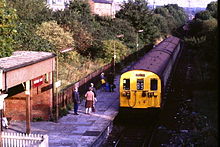
The Metropolitan line, colloquially known as the Met, is a London Underground line between Aldgate in the City of London and Amersham and Chesham in Buckinghamshire, with branches to Watford in Hertfordshire and Uxbridge in Hillingdon. Printed in magenta on the tube map, the line is 41.4 miles (66.7 km) in length and serves 34 stations. Between Aldgate and Finchley Road, the track is mostly in shallow "cut and cover" tunnels, apart from short sections at Barbican and Farringdon stations. The rest of the line is above ground, with a loading gauge of a similar size to those on main lines. Just under 67 million passenger journeys were made on the line in 2011/12.

The Bakerloo line is a London Underground line that runs from Harrow & Wealdstone in suburban north-west London to Elephant & Castle in south London, via the West End. Printed in brown on the Tube map, it serves 25 stations, 15 of which are underground, over 23.2 kilometres (14.4 mi). It runs partly on the surface and partly through deep-level tube tunnels.

Watford tube station is the terminus of a Metropolitan line branch line in the north-western part of the London Underground in Zone 7. The station opened in 1925.
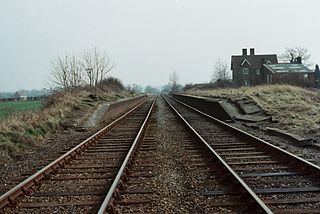
Verney Junction railway station was an isolated railway station at a four-way railway junction in Buckinghamshire, open from 1868 to 1968; a junction existed at the site without a station from 1851.
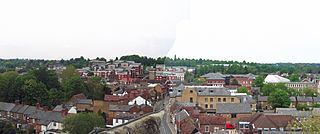
Rickmansworth, is a town in south-west Hertfordshire, England; it is located about 17 miles (27 km) north-west of central London, 5 miles (8 km) south-west of Watford and is inside the perimeter of the M25 motorway. The town is mainly to the north of the Grand Union Canal and the River Colne.

Watford Junction is a railway station that serves Watford, Hertfordshire. The station is on the West Coast Main Line (WCML), 17 miles 34 chains from London Euston and the Abbey Line, a branch line to St Albans. Journeys to London take between 16 and 52 minutes depending on the service used: shorter times on fast non-stop trains and slower on the stopping Watford DC line services. Trains also run to Clapham Junction and East Croydon via the West London Line. The station is a major hub for local bus services and the connecting station for buses to Warner Bros. Studio Tour London – The Making of Harry Potter. The station is located north of a viaduct over the Colne valley and immediately south of Watford Tunnel.
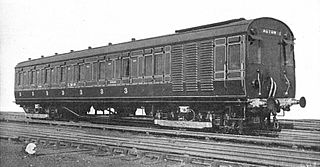
The London, Midland and Scottish Railway (LMS) was involved in the development of railway electrification of Britain. Like the LNER and the SR the LMS took over several schemes that had been developed by its constituent companies and also completed some of its own. All were suburban lines, in London, Liverpool and Manchester, and were usually steam lines converted to electric traction. Each service is listed below, showing dates of opening and the railway responsible for its conversion.

Uxbridge Vine Street station opened on 8 September 1856 as Uxbridge Station and was the earliest of three railway stations in Uxbridge, London.

The LNWR electric units were ordered by the London and North Western Railway for its suburban services in London. The first cars, made with Siemens equipment, arrived in 1914, and these were followed by two larger batches of units with Oerlikon equipment. The trains were formed into 3-car units, with first and third class accommodation in open saloons. Following the 1923 grouping and absorption of the line into the London, Midland and Scottish Railway (LMS), similar LMS electric units, but with accommodation in compartments, were purchased to run with the Oerlikon units in 1926 and 1932. The trains were all withdrawn by 1960.

Croxley is a London Underground station located on Watford Road (A412) in Croxley Green, Rickmansworth, Hertfordshire, on the Watford branch of the Metropolitan line. It is the only intermediate station on the branch between Moor Park, on the main line from Baker Street to Amersham, and the terminus at Watford.

Watford Stadium Halt railway station was a railway station in Watford, Hertfordshire, United Kingdom on the branch line from Watford Junction to Croxley Green. It served Vicarage Road stadium, home of Watford F.C., and was open only on match days.

Watford High Street is a railway station in Watford, Hertfordshire, United Kingdom. It is served by the Watford DC line on the London Overground network. It is the only station on the line's sole deviation from the West Coast Main Line.

The Watford DC line is a suburban line from London Euston to Watford Junction in Watford, Hertfordshire. Its services are operated by London Overground.

Croxley Green railway station is a disused terminus between Rickmansworth and Watford on the A412 road at the end of a short branch line. Work began on the line in 1908 in response to the growing influence of the Metropolitan Railway, with a new passenger service to serve the Grand Union Canal.

Rickmansworth railway station was a London and North Western Railway (LNWR) station in Rickmansworth, Hertfordshire, UK. Opened in 1862, it was the terminus of a 4.5-mile (7.2 km) branch line which used to run from Watford. The station closed to passengers in 1952, although the line continued to be used as a goods line until 1967. Church Street station has since been demolished. Rickmansworth station is about 0.5 miles (0.80 km) northwest of the site of Church Street station. Opening on 1 September 1887, it continues to serve both the London Underground Metropolitan line and Chiltern Railways between Marylebone and Aylesbury via Harrow-on-the-Hill.

The Croxley Rail Link, or the Metropolitan Line Extension, is a proposed railway engineering project in the Watford and Three Rivers districts of Hertfordshire, England, that would have connected the London Overground and the London Underground's Metropolitan line at Watford Junction. If the link were to go ahead, the Metropolitan line's terminus at Watford Underground station would be closed and the line diverted and extended from Croxley to Watford Junction via a reopened section of closed line. The main proponent of the scheme has been Hertfordshire County Council but it failed to win the support of Transport for London (TfL) which owns the Watford branch. The engineering works would have consisted of the realignment of the disused Watford and Rickmansworth Railway's line between Croxley Green and Watford High Street, with the construction of a viaduct over the Grand Union Canal, River Gade and A412 road and two new stations before branching into the London Overground line near Watford High Street and continuing to Watford Junction.
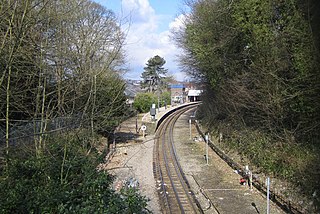
The Chesham branch is a single-track railway branch line in Buckinghamshire, England, owned and operated by the London Underground. It runs from a junction at Chalfont & Latimer station on the Metropolitan line for 3.89 miles (6.26 km) northwest to Chesham. The line was built as part of Edward Watkin's scheme to turn his Metropolitan Railway (MR) into a direct rail route between London and Manchester, and it was envisaged initially that a station outside Chesham would be an intermediate stop on a through route running north to connect with the London and North Western Railway (LNWR). Deteriorating relations between the MR and LNWR led to the MR instead expanding to the northwest via Aylesbury, and the scheme to connect with the LNWR was abandoned. By this time much of the land needed for the section of line as far as Chesham had been bought. As Chesham was at the time the only significant town near the MR's new route, it was decided to build the route only as far as Chesham, and to complete the connection with the LNWR at a future date if it proved desirable. Local residents were unhappy at the proposed station site outside Chesham, and a public subscription raised the necessary additional funds to extend the railway into the centre of the town. The Chesham branch opened in 1889.

Watford Vicarage Road is a proposed London Underground station in Watford, Hertfordshire. The station is proposed to be part of the approved, but currently suspended due to funding, Croxley Rail Link project, a scheme to extend the Metropolitan line to Watford Junction railway station, served by Metropolitan line trains between Watford Junction and Central London via Baker Street. Originally the station was to be named either Watford Hospital or Watford General Hospital. On 25 January 2017, the Watford Observer newspaper published an update on the Croxley Rail Link confirming work had stopped as there was an ongoing funding issue.
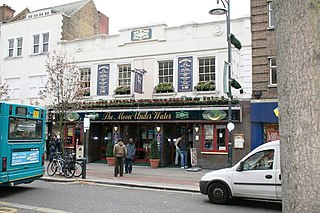
Watford Central, a planned London Underground station in the centre of Watford, Hertfordshire, was to be the terminus of a proposed extension of the Metropolitan line from the present-day Watford tube station to the High Street opposite Clarendon Road. The proposed station booking hall has long gone, however, the facade was retained and a new building constructed behind it. It is now The Moon Under Water public house.
Croxley Green Light Maintenance Depot was a traction maintenance depot located in Croxley, Watford, England that provided storage and light maintenance for electric multiple units working the Watford DC line.











